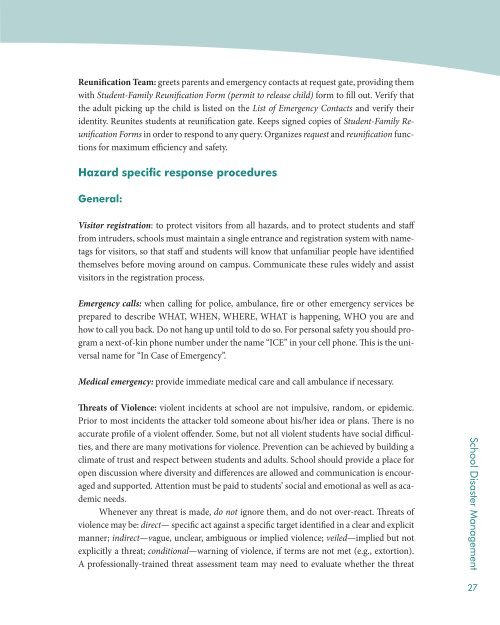Disaster and Emergency Preparedness: Guidance for ... - INEE Toolkit
Disaster and Emergency Preparedness: Guidance for ... - INEE Toolkit
Disaster and Emergency Preparedness: Guidance for ... - INEE Toolkit
You also want an ePaper? Increase the reach of your titles
YUMPU automatically turns print PDFs into web optimized ePapers that Google loves.
Reunification Team: greets parents <strong>and</strong> emergency contacts at request gate, providing themwith Student-Family Reunification Form (permit to release child) <strong>for</strong>m to fill out. Verify thatthe adult picking up the child is listed on the List of <strong>Emergency</strong> Contacts <strong>and</strong> verify theiridentity. Reunites students at reunification gate. Keeps signed copies of Student-Family ReunificationForms in order to respond to any query. Organizes request <strong>and</strong> reunification functions<strong>for</strong> maximum efficiency <strong>and</strong> safety.Hazard specific response proceduresGeneral:Visitor registration: to protect visitors from all hazards, <strong>and</strong> to protect students <strong>and</strong> stafffrom intruders, schools must maintain a single entrance <strong>and</strong> registration system with nametags<strong>for</strong> visitors, so that staff <strong>and</strong> students will know that unfamiliar people have identifiedthemselves be<strong>for</strong>e moving around on campus. Communicate these rules widely <strong>and</strong> assistvisitors in the registration process.<strong>Emergency</strong> calls: when calling <strong>for</strong> police, ambulance, fire or other emergency services beprepared to describe WHAT, WHEN, WHERE, WHAT is happening, WHO you are <strong>and</strong>how to call you back. Do not hang up until told to do so. For personal safety you should programa next-of-kin phone number under the name “ICE” in your cell phone. This is the universalname <strong>for</strong> “In Case of <strong>Emergency</strong>”.Medical emergency: provide immediate medical care <strong>and</strong> call ambulance if necessary.Threats of Violence: violent incidents at school are not impulsive, r<strong>and</strong>om, or epidemic.Prior to most incidents the attacker told someone about his/her idea or plans. There is noaccurate profile of a violent offender. Some, but not all violent students have social difficulties,<strong>and</strong> there are many motivations <strong>for</strong> violence. Prevention can be achieved by building aclimate of trust <strong>and</strong> respect between students <strong>and</strong> adults. School should provide a place <strong>for</strong>open discussion where diversity <strong>and</strong> differences are allowed <strong>and</strong> communication is encouraged<strong>and</strong> supported. Attention must be paid to students’ social <strong>and</strong> emotional as well as academicneeds.Whenever any threat is made, do not ignore them, <strong>and</strong> do not over-react. Threats ofviolence may be: direct— specific act against a specific target identified in a clear <strong>and</strong> explicitmanner; indirect—vague, unclear, ambiguous or implied violence; veiled—implied but notexplicitly a threat; conditional—warning of violence, if terms are not met (e.g., extortion).A professionally-trained threat assessment team may need to evaluate whether the threatSchool <strong>Disaster</strong> Management27
















